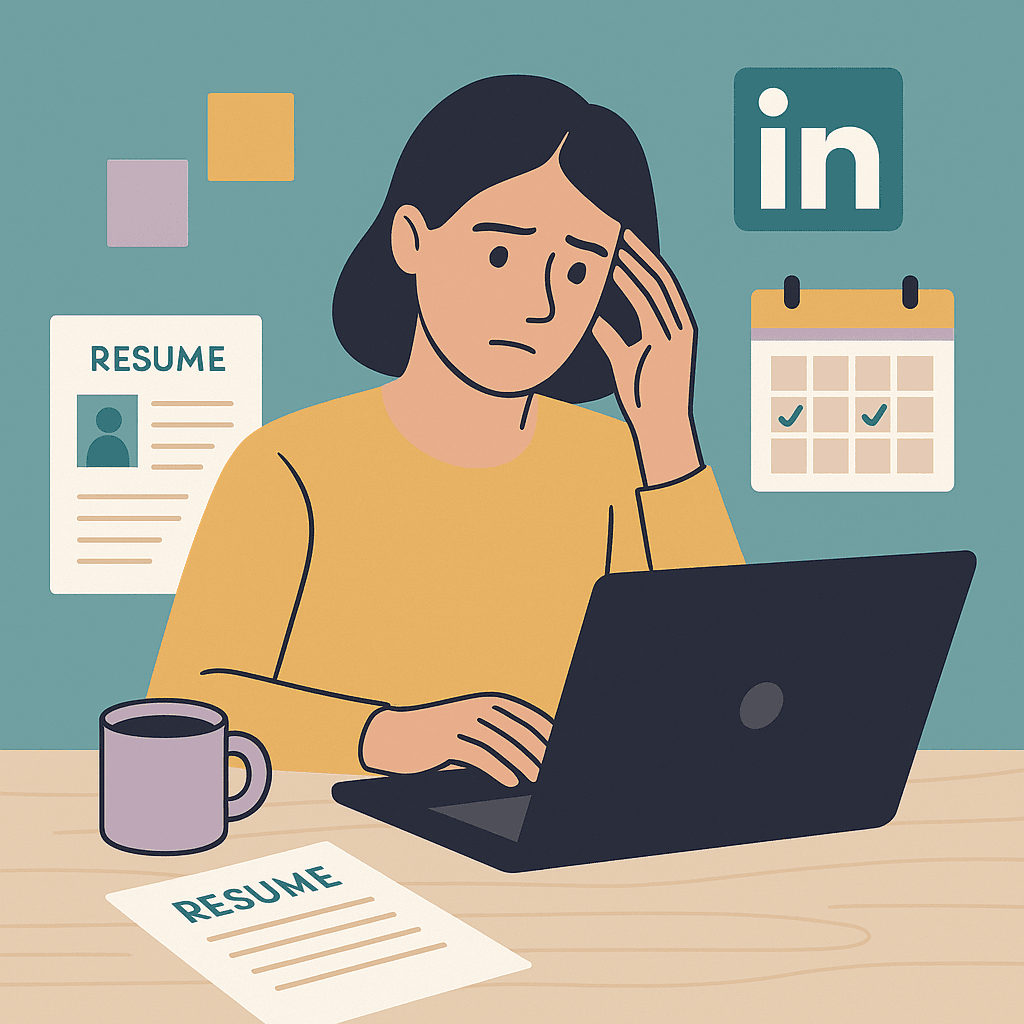Job hunting is the worst group project you’ll ever do — except you’re the whole group. And you don’t even get snacks. But it’s a necessary evil, so you might as well be good at it.
Whether you’re changing careers, escaping a toxic manager, or just chasing that sweet, sweet health insurance, here are the job search tips every functional human should know (from our experience being on both sides!)
1. Calibrate your expectations (and your emotions)
Even in the best case scenario, you’re likely to interview at only a small number of the places where you apply. That’s normal.
You’ll get ghosted. You’ll hear a lot of (polite) “no thank yous.” You might overanalyze any number of your answers from an interview. Resist the spiral. It’s part of the process. There are so many random things that can happen behind the scenes, so it’s not always a verdict on your worth.
Let out a good screech if you need it, and move on.
2. Know what you’re looking for
Yes, salary matters — but so does everything else. Figure out what you want in terms of role, industry, location, team vibe, and flexibility. What kind of work lights you up? What kind drains you? If you thrive on office gossip (and free coffee), remote work might not be your thing and that’s okay.
If you’re not clear on what you want, it’s much harder to find (or land) it. Start narrow. Bonus: it also makes interviews a lot easier when you know how to explain why this job actually fits you.
3. Create a resume that doesn’t just list stuff
Your resume isn’t just a list of job descriptions. It’s a highlight reel. The number one mistake people make is focusing on what you were responsible for instead of what you accomplished.
Tailor it slightly for each role, and make sure the parts you really want to get read are at the top. Sections you need to include:
- Contact Info (phone, professional email, city/state only)
- Summary or Highlights
- Work experience (with results)
- Education
- Relevant skills, tools, or certs
Ask a friend, mentor, or someone who’s done hiring to give it a once-over.
Need more help getting that resume polished? Check out our full guide to resumes that don’t suck.
4. Upgrade your online presence.
LinkedIn isn’t optional anymore. Keep it updated with your latest role, skills, and a human-sounding summary. Adjust your “Open to Work” settings and make sure your privacy settings match your vibe. Also: check your other social profiles. If you’d rather not have recruiters scrolling your spicy memes or vacation selfies, set them to “friends only.”
Pro tip: If you have anything to show off — a portfolio, writing samples, project screenshots — make a free Google Site or Notion page and link it in your applications.
5. Make each application count
Many jobs can attract dozens, hundreds, or thousands of applicants. In a sea of applicants, a generic resume and copy-paste cover letter won’t cut it. A great application answers three questions:
- Why this role?
- Why this company?
- Why you?
Yes, the ATS (Applicant Tracking System) exists — but humans are almost always still reading. Make it easy for them to see you’re a match by echoing keywords from the job post and always including a short but specific cover letter if they give the option.6.
6. Don’t just apply
It’s proven that “networking” and referrals are more likely to result in getting you hired. Don’t let those words scare you away. Let past coworkers, fellow students or family to let them know you’re job hunting. If you apply somewhere and see the hiring manager’s name? Send them a short, polite message expressing interest. Know your industry – sales jobs are expected to be a little more aggressive, for example. Follow industry folks on Linkedin to keep up on the latest.
You don’t have to be pushy. You just have to show up.
7. Track Your Applications (Your Brain Will Thank You)
Create a simple spreadsheet or note to track: What you applied to, When you applied, Any notes (referral, expected salary, vibe check). This keeps you from double-applying, helps you follow up, and lets you start spotting patterns (e.g., where you’re getting traction). Bonus points if you use color-coding, because we believe in organized chaos. We’ve also been known to create pivot tables and graphs…
8. Do your research.
By the time you go into an interview, you should know enough about the company to picture yourself working there:
- What the company does (and how they make money)
- Any recent news or announcements
- Who’s interviewing you (LinkedIn is your friend)
- What the job actually requires (not just the buzzwords)
Sites like Glassdoor can help with reviews and salary research, and company posts on Linkedin or their website news page will tell you about any recent developments. It’s almost guaranteed that an interviewer will ask what you know about the company. If the interviewer has posted articles or videos, even better — now they’re not a stranger, they’re a person with opinions you can connect with.
🎉 Bonus: Interviews!
Interviews don’t need to feel like an FBI interrogation. Practice a few key stories about your past experience — what you did, how you did it, and what happened — and be ready to talk about both wins and challenges. Above all, be yourself (the functional version). Check out all our interview hacks when you’re ready.
tl;dr
Job hunting is overwhelming. You’re not alone. These tips won’t make it fun, but they will make you more prepared, more confident, and more in control. You got this.
